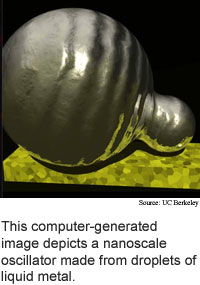
Surface tension drives nanomotor
Researchers from the University of California
at Berkeley have found a way to harness surface tension to drive nanomachines.
The researchers' nanoelectromechanical relaxation oscillator is
contained in a box that is 200 nanometers on a side and consists of a
pair of liquid metal droplets of different sizes on a carbon nanotube.
Carbon nanotubes are rolled-up sheets of carbon atoms. A nanometer is
one millionth of a millimeter.
When electrical current is run through the nanotube, metal atoms
move from the big droplet along the nanotube to the smaller droplet, shrinking
the big droplet while the smaller one grows. Eventually the droplets touch
above the nanotube and surface tension drives the bulk of the small droplet
back to the big one; as soon as this happens the process begins again.
The device could eventually be used as a nanorobot motor that
drives crawling, walking, swimming, jumping or flying motions; the physics
behind the device should also work at the microscale, according to the
researchers. A micron is one thousand nanometers.
This pattern of slow buildup of tension followed by rapid release
is found in many phenomena, including earthquakes, heartbeats, drippy
faucets, and political upheaval in unstable countries.
The device's peak power output is about 20 microwatts -- 3 million
times less than that required by a 60-watt lightbulb. However, the power
density achieved during the fast, surface-tension driven relaxation is
enormous: 100 million times more power per unit volume than a 225 horsepower,
3.3 liter V-6 car engine, according to the researchers.
The surface tension driven relaxation oscillator could be used
in practical microscale devices within two years using existing silicon-based
technology; it will take longer, however to implement the technology at
the nanoscale, according to the researchers. The work appeared in the
March 21, 2005 issue of Applied Physics Letters (Surface-Tension-Driven
Nanoelectromechanical Relaxation Oscillator).
Stories:
Memory mimic aids reading
Chip gauges cell reactions
View from the High Ground:
NYU's Nadrian Seeman
Briefs:
Surface tension drives nanomotor
Laser sniffs explosives
Nano pyramids boost fuel cells
Noisy snapshots show quantum weirdness

Research Watch blog
View from the High Ground Q&A
How It Works
RSS Feeds:
News
Ad links:
Buy an ad link
Ad links: Clear History
Buy an ad link
|
TRN
Newswire and Headline Feeds for Web sites
|
© Copyright Technology Research News, LLC 2000-2010. All rights reserved.